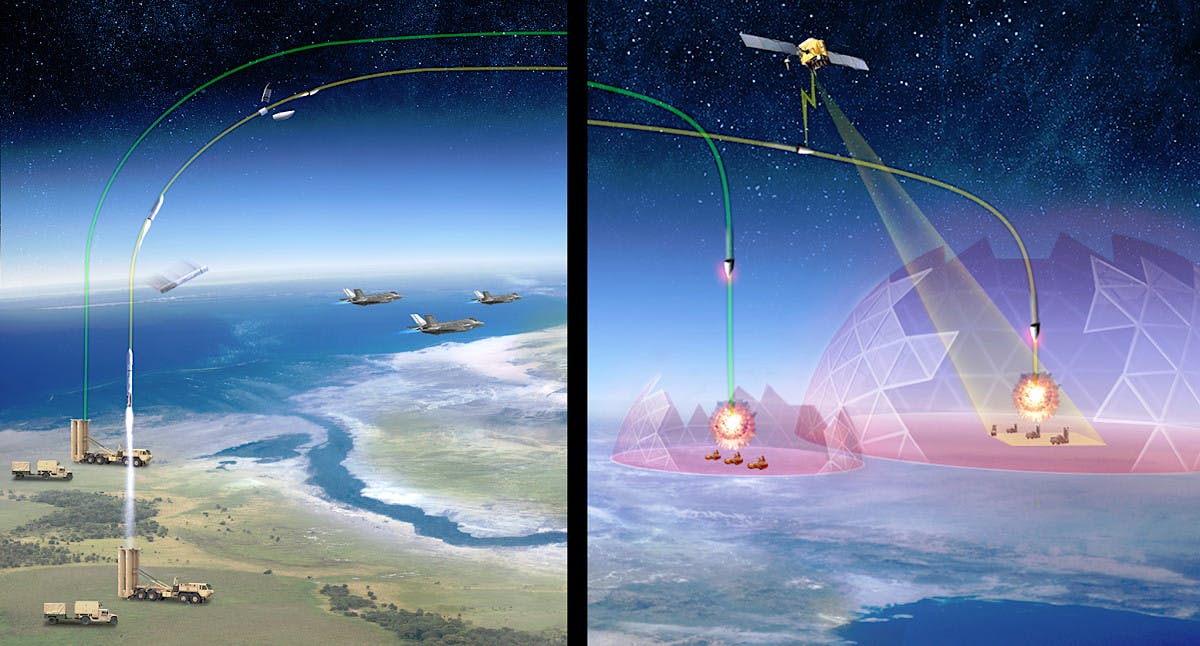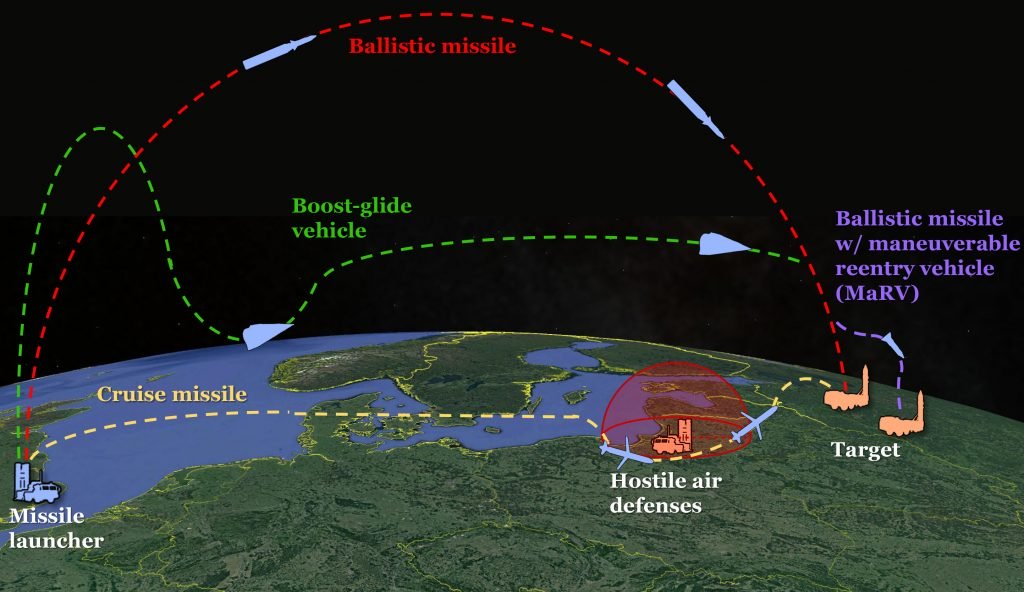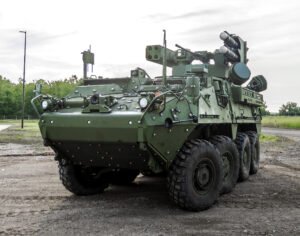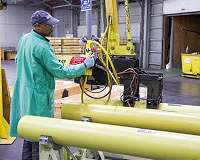Army Ramps Up Funding For Laser Shield, Hypersonic Sword
Army Ramps Up Funding For Laser Shield, Hypersonic Sword
Research and development spending on hypersonics will nearly double in ‘21, and it will triple for lasers, as the service rushes to deploy combat-ready prototypes.
By
SYDNEY J. FREEDBERG JR.on February 28, 2020 at 10:39 AM
Notional flight paths of hypersonic boost-glide missiles, ballistic missiles, and cruise missiles. (CSBA graphic)
WASHINGTON: With
adversaries amassing long-range precision weapons, the Army is asking Congress for more than $1 billion in 2021 to develop hypersonic missiles for offense and
missile-killing lasers for defense. Hypersonics funding is up 86 percent from last year and high energy lasers soared a stunning
209 percent.
The aim of all this money is to move technology out of the lab and into mass production, so the service can field its first
50-kilowatt lasers on Stryker armored vehicles in 2022, its first
truck-launched hypersonics in 2023, and truck-mounted lasers in the
100-300 kW class in 2024.
Lt. Gen. Neil Thurgood
The Army wants these technologies so urgently it’s devoted a unique unit to developing them, the
Rapid Capabilities & Critical Technologies Office. RCCTO’s priority is so high that its director,
Lt. Gen. Neil Thurgood, told me he speaks to the Amy’s civilian acquisition executive,
Bruce Jette, and the head of Army Futures Command,
Gen. John “Mike” Murray, “multiple times a week, sometimes multiple times a day.” As for the Army’s top four leaders – Sec.
Ryan McCarthy, Undersec.
James McPherson, Chief of Staff
Gen. James McConville, and Vice-Chief
Gen. Joseph Martin – Thurgood meets with them “multiple times throughout the month.”
Why so much urgency and high-level attention?
Strategic Offense, Operational Defense
“Our potential adversaries have created the A2/AD environment,” Thurgood told me in an interview. That’s short for
Anti-Access/Area Denial, the Pentagon term of art for the dense layered defenses of long-range weapons – anti-aircraft, anti-ship, and ground attack – that Russia, China, and even North Korea and Iran are building
to keep US forces at bay.
 AIR WARFARE, SPONSORED
Flexibility On The Fly
AIR WARFARE, SPONSORED
Flexibility On The Fly
Joint Strike Missile Has Abilities That Give Pilots The Upper Hand.
From
RAYTHEON
“In order to move forces into that, you’ve got to create lanes of penetration,” Thurgood said. “Hypersonics is a strategic weapon that does that.”
The Army wants hypersonics for precision non-nuclear strikes against high-priority linchpins of the enemy defense, like hardened command posts and anti-aircraft systems. That should rip open seams in the A2/AD zone through which other forces – not just Army but Air Force, Marine, and Navy as well – can advance in what’s called a
Joint All Domain Operation, much like how Panzers and Stukas led the way for German infantry during the blitzkrieg.
SOURCE: Army Multi-Domain Operations Concept, December 2018.
But the US must also protect its own forces from the enemy’s long-range missiles. Today, that’s the role of missile defense systems like
Patriot,
THAAD, and
Aegis. But shooting down a missile with another missile is an expensive proposition. An interceptor that can hit another missile in flight is much more sophisticated and expensive than a missile that can hit a target on the ground: A Patriot costs $3 million, about the same as three Scuds. So a well-resourced attacker like Russia or China can “flood the zone” with cheap offensive missiles until the missile defenders run out of shots.
Hence the attraction of laser weapons, which not only shoot at the speed of light – making an intercept much easier – but also can keep shooting as long as they have electrical power. Lasers have their limits, however. Bad weather bothers them more than it does missiles, and their energy output is still too low to defeat most targets, although the Pentagon has an urgent joint effort underway to ramp up power.
 RecommendedHypersonic Missiles: Plethora Of Boost-Glide & Cruise
RecommendedHypersonic Missiles: Plethora Of Boost-Glide & Cruise
“At this point we don’t want to see an either/or — we actually want to see both technologies pursued,” Lewis said of DoD’s pursuit of hypersonic boost-glide and cruise missile efforts.
By
THERESA HITCHENS
At least for the near term, while hypersonics are what the Army is calling
strategic fires, “directed energy is much more on that tactical/operational side,” Thurgood told me. Those are very much for what we would call a point defense or an area defense. Not really at this point do we have lasers that are strategic weapons. My assessment is that technology is still advancing towards that end game.”
Timelines & Transitions
The most tactical system, with the lowest power and the earlier fielding date, is the roughly 50-kilowatt weapon being developed to go on the Stryker armored vehicle. This laser goes by the acronym DE-SHORAD, which is mercifully short for Directed Energy
– Maneuver Short-Range Air Defense. The Army is already building MSHORAD Strykers that will use guns and missiles to shoot down enemy drones, helicopters, and even low-flying attack jets. But it is eager to add laser weapons to the mix, starting with an initial platoon of four vehicles in 2022.
Stryker anti-aircraft variant, IM-SHORAD (Interim Maneuver Short-Range Air Defense), armed with guns and missiles. A laser-armed variant will enter service in 2022.
While 8×8 Stryker can keep up with frontline mechanized forces over rough terrain, it can’t carry
a laser large enough to defeat cruise missiles. That’s the role of the IFPC High Energy Laser, a roughly 300-kW weapon mounted on a heavy tuck.
As with MSHORAD, there are other versions of IFPC, the
Indirect Fire Protection Capability, that use more conventional weapons such as missiles. IFPC will hang back behind the front, covering command posts and other crucial targets that aren’t constantly on the move.
“The DE-MSHORAD is on a Stryker there because they go with the maneuver force,” Thurgood said. “IFPC’s on a truck for fixed and semi-fixed locations.”
Thurgood’s role at RCCTO is to field combat-capable prototypes of these technologies – an initial platoon or battery of each to prove out the technology, experiment with tactics, and if necessary fight.
As each weapon matures and moves into the field, he explained, his RCCTO will hand it over the Army’s normal acquisition organization, the Program Executive Office for Missiles & Space, led by Maj. Gen. Robert Rash. Rash’s PEO already has a transition team embedded with Thurgood’s RCCTO for each weapon to smooth the handover. If all proceeds as planned, then each weapon will move from RCCTO to the PEO a year after its initial fielding and become a formal Program Of Record:
- The first platoon of 50-kW Strykers will enter service in 2022, and the DE-SHORAD effort will transition to PEO Missiles & Space in 2023.
- The first battery of Long-Range Hypersonic Weapons will enter service in 2023, and the LRHW effort will transition to the PEO in 2024.
- The 300-kW truck-borne laser will enter service in 2024, and the IFPC High Energy Laser effort will transition to the PEO in 2025.
Show Me the Money
If you look at the recently released budget request for 2021, you’ll see funding in the Research, Development, Test, & Evaluation (RDTE) accounts for all these weapons. Most of it falls under Advanced Technology Development and Advanced Component Development & Prototypes: These are levels 3 and 4 respectively on an
scale from Budget Activity 1, Basic Research, to Budget Activity 7, Operational System Development.
What
you won’t see is the procurement funding for the PEO to actually start mass-producing hypersonics or lasers once Thurgood hands them over.
“They’re working on that,” Thurgood told me. “You’ll probably see that in about ’22” – that is, as part of next year’s budget request for fiscal 2022. But before the Army can nail down those numbers, he said, the service’s headquarters staff in the Pentagon has to figure out how many batteries it wants of each, which in turn depends on how the new technology fits into its evolving concepts of future conflict and specific joint war plans.
Breaking Defense graphic from Army FY21 budget data
That said, the RCCTO is laying the groundwork for mass production. The challenge here is that, while there are plenty of private companies building lasers for industrial cutting, and a fair number of defense contractors building booster rockets that can get a hypersonic weapon up to speed,
there is no industrial base to mass-produce
hypersonic glide bodies, the part of the weapon that actually strikes the target. The technology is too new and its manufacture too challenging.
In fact, the Common Glide Body that both the Army and
Navy hypersonic missiles will use was developed and is still being built, not by any defense contractor, but by Sandia National Laboratory, a government-owned facility most famous for research on nuclear weapons. Starting last year, the Army has contracted with private-sector companies like
Dynetics to build facilities for mass production. Those companies now have teams at Sandia learning about the technology from its inventors.
Why not just keep the work in the lab? “Labs are great, they do wonderful work, but they’re not necessarily great producers of multiples of things,” Thurgood said. “We’ve got to get out of the craftsman lab approach into a commercialized approach. That’s what’s happening right now.”
“There’s not a single prime doing all this work,” he added. “It’s actually about
four or five major contracts and then a bunch of minor contracts.”
Dynetics concept for their Common Hypersonic Glide Body (C-HGB)
In the interests of speed and efficiency, there’s a marked amount of inter-service cooperation underway. The Army manages the contract to build the Common Glide Body – the most technically challenging piece of the weapon – and gets reimbursed out of the Navy budget for glide bodies that go the sea service. Conversely, the Navy manages the contract to build the rocket booster or “stack”– which, while less bleeding-edge, is still literally rocket science – and gets reimbursed out of the Army budget for boosters that go to the ground force. Each service then customizes its combined glide-body-and-booster to be launched either off trucks or naval vessels.
The Air Force wants to launch its hypersonic missiles off airplanes, which is a very different technical problem, and it’s also exploring the most advanced technology – such
as “air-breathing” hypersonic cruise missiles that fly under continual thrust like a jet plane, instead of having a rocket booster launch a glide body. So the Air Force has its own separate programs. But all three services come together on a Common Hypersonic Glide Body Board of Directors, which meets at least quarterly – the most recent time was last week – with each service taking a turn as chairman – last week was Thurgood’s turn.
Breaking Defense graphic from Army FY21 budget data
“The joint coordination has been phenomenal,” he told me. “In the past, you might have seen we each had our own contract for each of these things. That’s too slow and too expensive.”
So when you look at the $801 million for “Long-Range Hypersonic Weapon” under RDTE Budget Activity 4 in the Army budget request for 2021, that includes funds the service is transferring to the Navy to buy boosters.
But that $801 million in Research & Development isn’t everything the Army is spending on hypersonics. There’s another $30 million in Science & Technology.
UPDATE Helpful Army budgeteers have pointed out another $20 million or so we missed — we’ll update this story when we nail down the numbers.
UPDATE ENDS
“While we’re doing this, you can’t also walk away from the future, so there’s still S&T work going on,” Thurgood said. After the initial version is fielded, he said, “What is block two? What is block three?….You keep modifying, based on what the threat is doing.”
There’s joint cooperation on high-energy lasers as well, led by
Thomas Karr, the Pentagon’s assistant director for directed energy. Within the Army budget for 2021, the biggest item by far is $212.3 million under Budget Activity 5 — System Development & Demonstration (SDD) – for the Stryker-mounted 50-kW laser, DE M-SHORAD. (That figure isn’t in the budget, but it’s the laser-specific portion of a larger $284.2 million line item for M-SHORAD overall, Army officials explained).
But, as with hypersonics, there are multiple budget lines for lasers at different stages of RDTE, totally another $66 million. To break it down, the ’21 request asks for $28.2 million in Applied Research (Budget Activity 2), $29.7 million in Advanced Technology Development (BA 3), and $8.1 million in Advanced Component Development & Prototypes (BA 4).
That’s actually less than the total appropriated — $90 million — for High Energy Lasers in those three categories in 2020. Why? Because more and more, these technologies are
moving up the scale from early research to prototyping and, soon, production.







 Steve Trimble@TheDEWLine
Steve Trimble@TheDEWLine















